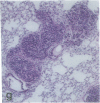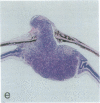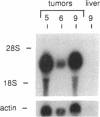Abstract
Ocular and cutaneous melanomas arose in new inbred lines of transgenic mice having an integrated recombinant gene comprised of the tyrosinase promoter, expressed in pigment cells, and the simian virus 40 early-region transforming sequences. The tumors were hypomelanotic and were histopathologically similar to corresponding human melanomas. Eye melanomas often originated at a young age, chiefly from the retinal pigment epithelium, also from the choroid, and rarely from the ciliary body. The eye tumors grew aggressively, were highly invasive, and metastasized to local and distant sites. The earliest formation of these tumors was associated with higher copy numbers of the transgene; mice of different single-copy lines varied greatly in age of onset and frequency of eye tumors. Coat pigmentation was reduced in almost all lines, to various extents. Primary skin melanomas arose later and less frequently than eye melanomas. Hence they were at early stages and of unknown long-range incidence in this investigation, in which autopsies covered the first half-year of life. For both ocular and cutaneous melanomas, the transgenic mice offer numerous possibilities for experimental study of mechanisms underlying formation and spread of melanomas.
Full text
PDF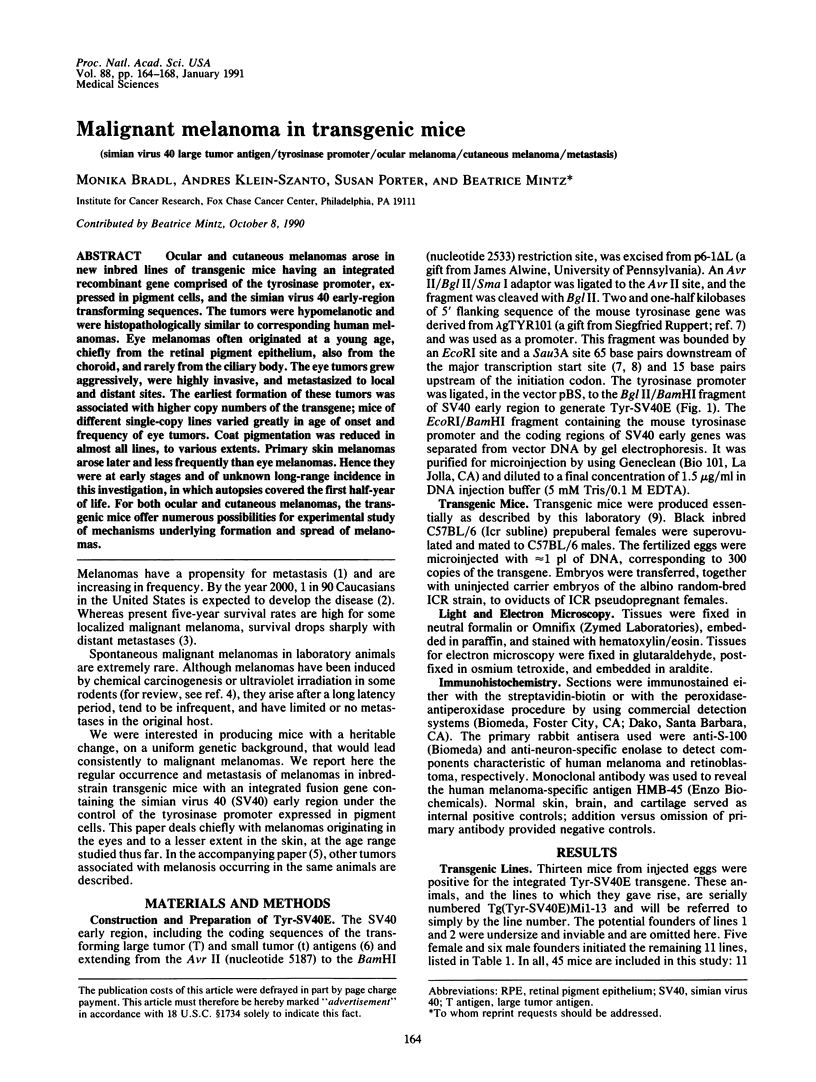
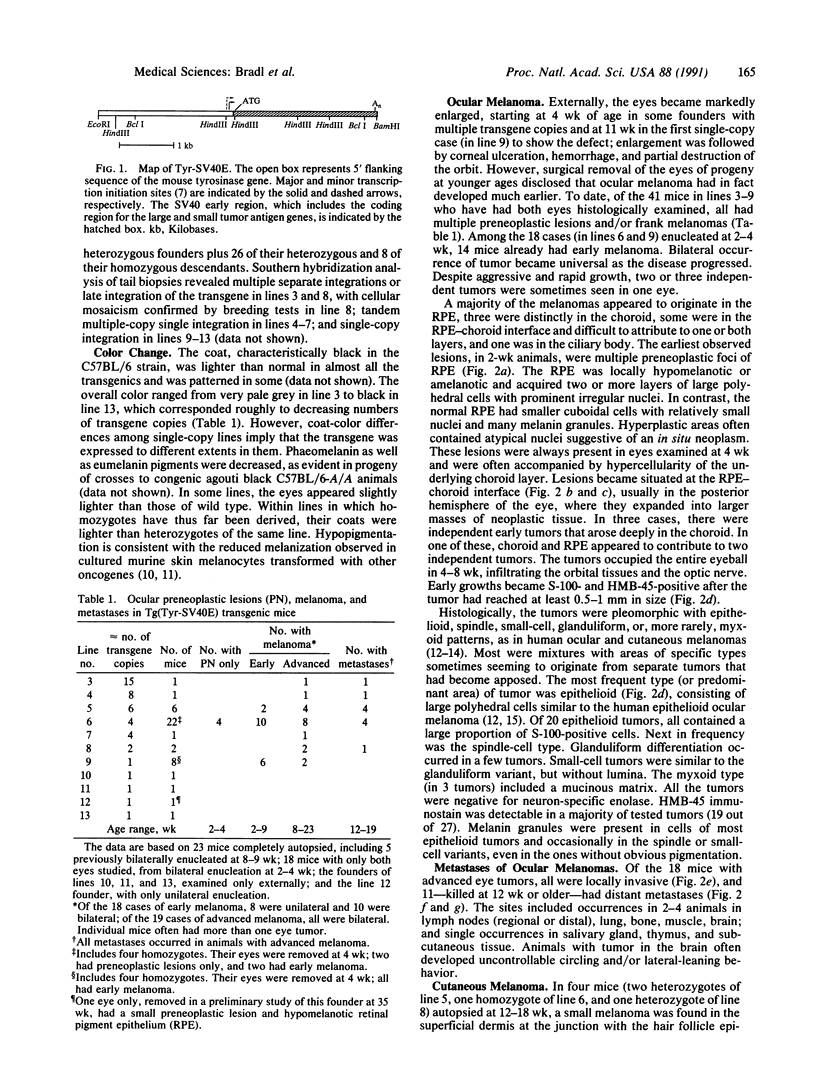
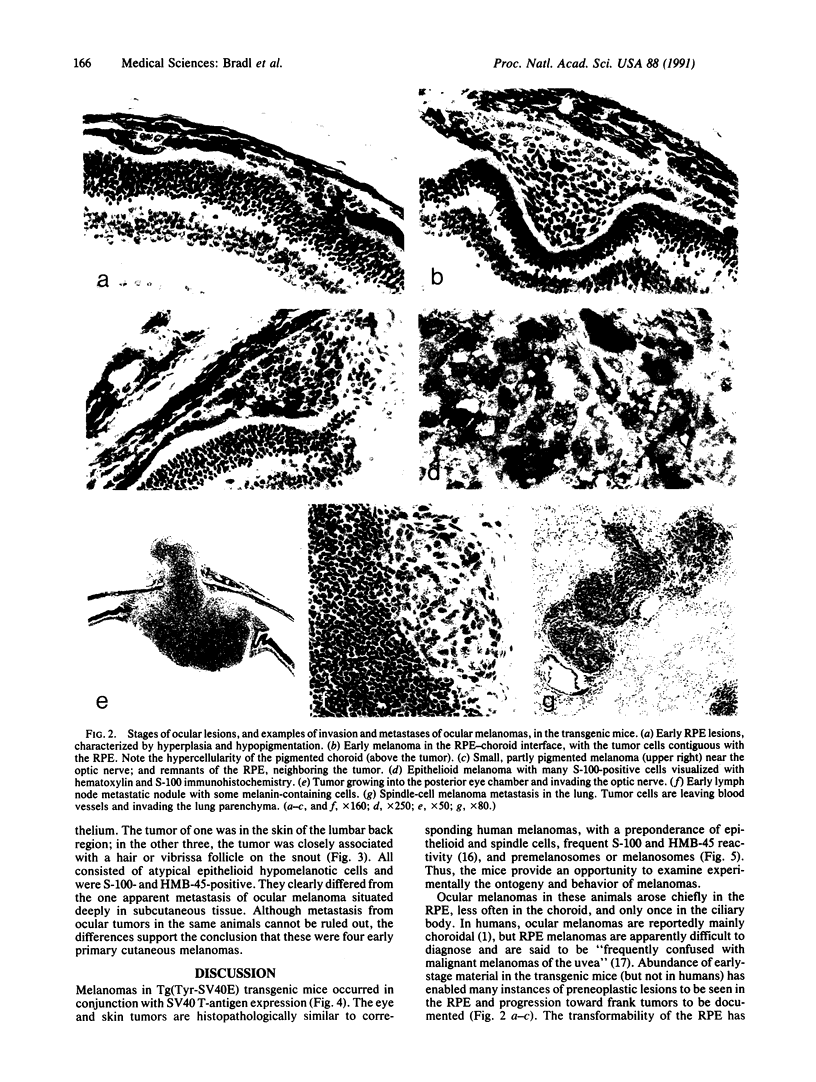
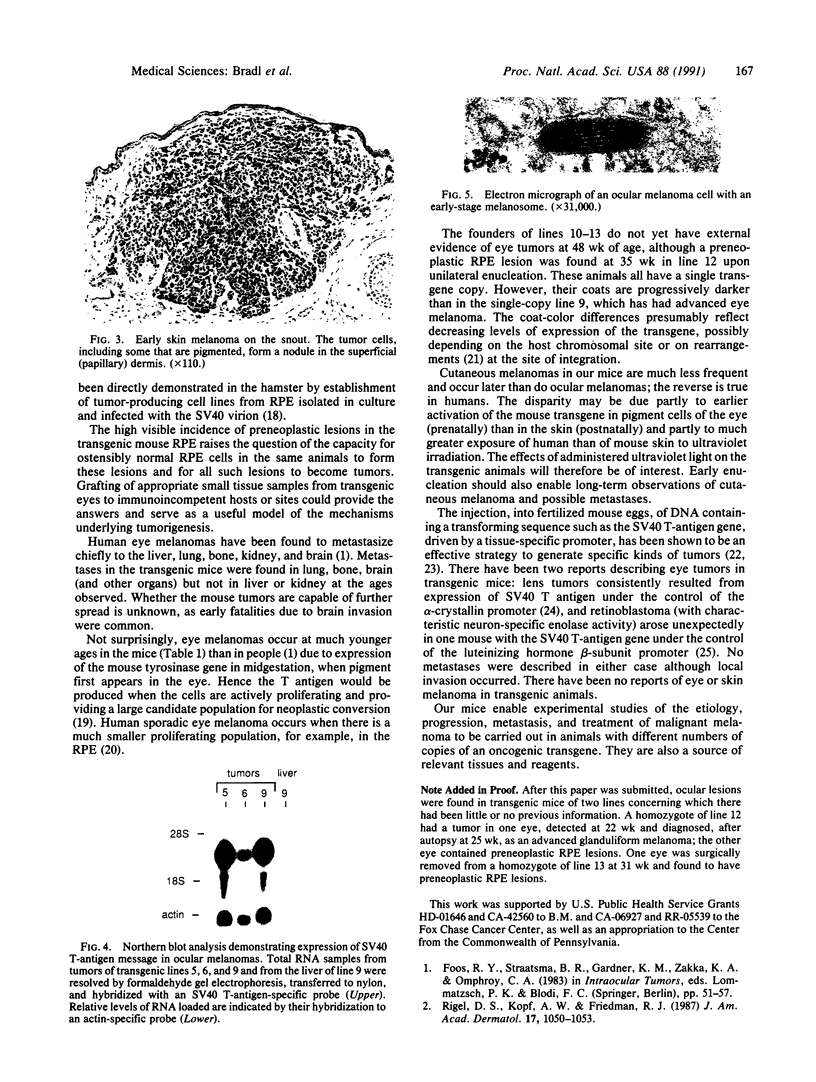
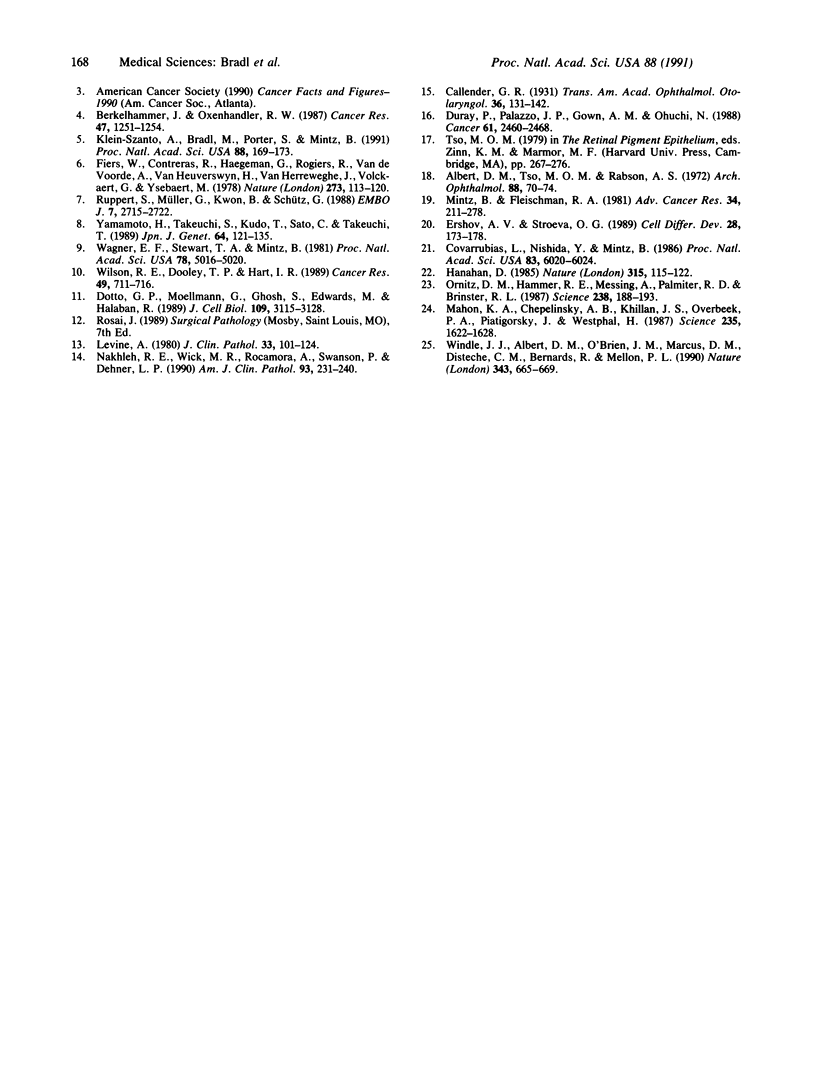
Images in this article
Selected References
These references are in PubMed. This may not be the complete list of references from this article.
- Albert D. M., Tso M. O., Rabson A. S. Experimental malignant tumors from retinal pigment epithelium. Arch Ophthalmol. 1972 Jul;88(1):70–74. doi: 10.1001/archopht.1972.01000030072015. [DOI] [PubMed] [Google Scholar]
- Berkelhammer J., Oxenhandler R. W. Evaluation of premalignant and malignant lesions during the induction of mouse melanomas. Cancer Res. 1987 Mar 1;47(5):1251–1254. [PubMed] [Google Scholar]
- Covarrubias L., Nishida Y., Mintz B. Early postimplantation embryo lethality due to DNA rearrangements in a transgenic mouse strain. Proc Natl Acad Sci U S A. 1986 Aug;83(16):6020–6024. doi: 10.1073/pnas.83.16.6020. [DOI] [PMC free article] [PubMed] [Google Scholar]
- Dotto G. P., Moellmann G., Ghosh S., Edwards M., Halaban R. Transformation of murine melanocytes by basic fibroblast growth factor cDNA and oncogenes and selective suppression of the transformed phenotype in a reconstituted cutaneous environment. J Cell Biol. 1989 Dec;109(6 Pt 1):3115–3128. doi: 10.1083/jcb.109.6.3115. [DOI] [PMC free article] [PubMed] [Google Scholar]
- Duray P. H., Palazzo J., Gown A. M., Ohuchi N. Melanoma cell heterogeneity. A study of two monoclonal antibodies compared with S-100 protein in paraffin sections. Cancer. 1988 Jun 15;61(12):2460–2468. doi: 10.1002/1097-0142(19880615)61:12<2460::aid-cncr2820611213>3.0.co;2-r. [DOI] [PubMed] [Google Scholar]
- Ershov A. V., Stroeva O. G. Post-natal pattern of cell proliferation in retinal pigment epithelium of mice studied with tritiated thymidine autoradiography. Cell Differ Dev. 1989 Dec;28(3):173–177. doi: 10.1016/0922-3371(89)90002-6. [DOI] [PubMed] [Google Scholar]
- Fiers W., Contreras R., Haegemann G., Rogiers R., Van de Voorde A., Van Heuverswyn H., Van Herreweghe J., Volckaert G., Ysebaert M. Complete nucleotide sequence of SV40 DNA. Nature. 1978 May 11;273(5658):113–120. doi: 10.1038/273113a0. [DOI] [PubMed] [Google Scholar]
- Hanahan D. Heritable formation of pancreatic beta-cell tumours in transgenic mice expressing recombinant insulin/simian virus 40 oncogenes. Nature. 1985 May 9;315(6015):115–122. doi: 10.1038/315115a0. [DOI] [PubMed] [Google Scholar]
- Klein-Szanto A., Bradl M., Porter S., Mintz B. Melanosis and associated tumors in transgenic mice. Proc Natl Acad Sci U S A. 1991 Jan 1;88(1):169–173. doi: 10.1073/pnas.88.1.169. [DOI] [PMC free article] [PubMed] [Google Scholar]
- Levene A. On the histological diagnosis and prognosis of malignant melanoma. J Clin Pathol. 1980 Feb;33(2):101–124. doi: 10.1136/jcp.33.2.101. [DOI] [PMC free article] [PubMed] [Google Scholar]
- Mahon K. A., Chepelinsky A. B., Khillan J. S., Overbeek P. A., Piatigorsky J., Westphal H. Oncogenesis of the lens in transgenic mice. Science. 1987 Mar 27;235(4796):1622–1628. doi: 10.1126/science.3029873. [DOI] [PubMed] [Google Scholar]
- Mintz B., Fleischman R. A. Teratocarcinomas and other neoplasms as developmental defects in gene expression. Adv Cancer Res. 1981;34:211–278. doi: 10.1016/s0065-230x(08)60243-2. [DOI] [PubMed] [Google Scholar]
- Ornitz D. M., Hammer R. E., Messing A., Palmiter R. D., Brinster R. L. Pancreatic neoplasia induced by SV40 T-antigen expression in acinar cells of transgenic mice. Science. 1987 Oct 9;238(4824):188–193. doi: 10.1126/science.2821617. [DOI] [PubMed] [Google Scholar]
- Rigel D. S., Kopf A. W., Friedman R. J. The rate of malignant melanoma in the United States: are we making an impact? J Am Acad Dermatol. 1987 Dec;17(6):1050–1053. doi: 10.1016/s0190-9622(87)80487-5. [DOI] [PubMed] [Google Scholar]
- Ruppert S., Müller G., Kwon B., Schütz G. Multiple transcripts of the mouse tyrosinase gene are generated by alternative splicing. EMBO J. 1988 Sep;7(9):2715–2722. doi: 10.1002/j.1460-2075.1988.tb03125.x. [DOI] [PMC free article] [PubMed] [Google Scholar]
- Wagner E. F., Stewart T. A., Mintz B. The human beta-globin gene and a functional viral thymidine kinase gene in developing mice. Proc Natl Acad Sci U S A. 1981 Aug;78(8):5016–5020. doi: 10.1073/pnas.78.8.5016. [DOI] [PMC free article] [PubMed] [Google Scholar]
- Wilson R. E., Dooley T. P., Hart I. R. Induction of tumorigenicity and lack of in vitro growth requirement for 12-O-tetradecanoylphorbol-13-acetate by transfection of murine melanocytes with v-Ha-ras. Cancer Res. 1989 Feb 1;49(3):711–716. [PubMed] [Google Scholar]
- Windle J. J., Albert D. M., O'Brien J. M., Marcus D. M., Disteche C. M., Bernards R., Mellon P. L. Retinoblastoma in transgenic mice. Nature. 1990 Feb 15;343(6259):665–669. doi: 10.1038/343665a0. [DOI] [PubMed] [Google Scholar]
- Yamamoto H., Takeuchi S., Kudo T., Sato C., Takeuchi T. Melanin production in cultured albino melanocytes transfected with mouse tyrosinase cDNA. Jpn J Genet. 1989 Apr;64(2):121–135. doi: 10.1266/jjg.64.121. [DOI] [PubMed] [Google Scholar]







